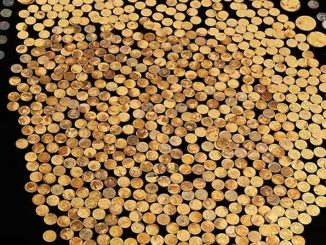“Archaeologists have discovered a small bedroom in a Roman villa near Pompeii used by slaves, shedding further light on their status in the ancient world,” the Italian Ministry of Culture said. knew on August 20.
The room was found by archaeologists at the Civita Giuliana villa, about 600 meters north of the walls of Pompeii, which was wiped out by an eruption of Mount Vesuvius nearly 2,000 years ago, according to Reuters.
The room had two beds, of which only one had a mattress, two small cabinets, a series of ceramic vases and containers, and the remains of mice.

The room has 2 beds, 2 small cabinets and some items (REUTERS)
“These details once again highlight the precarious conditions and poor hygiene in which the lower classes of society lived during that time,” the Italian Culture Ministry said in a statement.
Materials such as furniture and fabrics, covered with rock fragments, gas and ash from Vesuvius, have decomposed over the years.
Archaeologists also clearly saw the outline of a crumpled blanket left on the bed net. “It looks like a photo… However, this is an image from nearly 2,000 years ago,” the Italian Ministry of Culture confirmed.
Additionally, no traces of nets, locks or chains were found to restrict the movement of residents living in the room. “It seems that control was mainly exercised through the internal organization of slaves, rather than physical barriers and restrictions,” said Gabriel Zuchtriegel, Director of the Pompeii Archaeological Park.
Excavations at the Civita Giuliana villa were carried out in 1907-1908, and then again since 2017, when police realized the site was being looted by illegal diggers.

Inside the newly excavated room (REUTERS)
Part of one of the beds was destroyed inside a tunnel used by the robbers to access another part of the villa, archaeologists said.
Pompeii and the surrounding countryside were engulfed by volcanic ash from Vesuvius in 79 AD, burying thousands of Romans.
The site has seen a recent boom in archaeological activity aimed at halting the decay and neglect of many monuments, largely thanks to a $115 million EU-funded project.
Italian Culture Minister Gennaro Sangiuliano said on August 20 that conservation and research efforts would continue. “What we are learning about the material conditions and social organization of that time opens up new horizons for historical and archaeological research,” he said.


